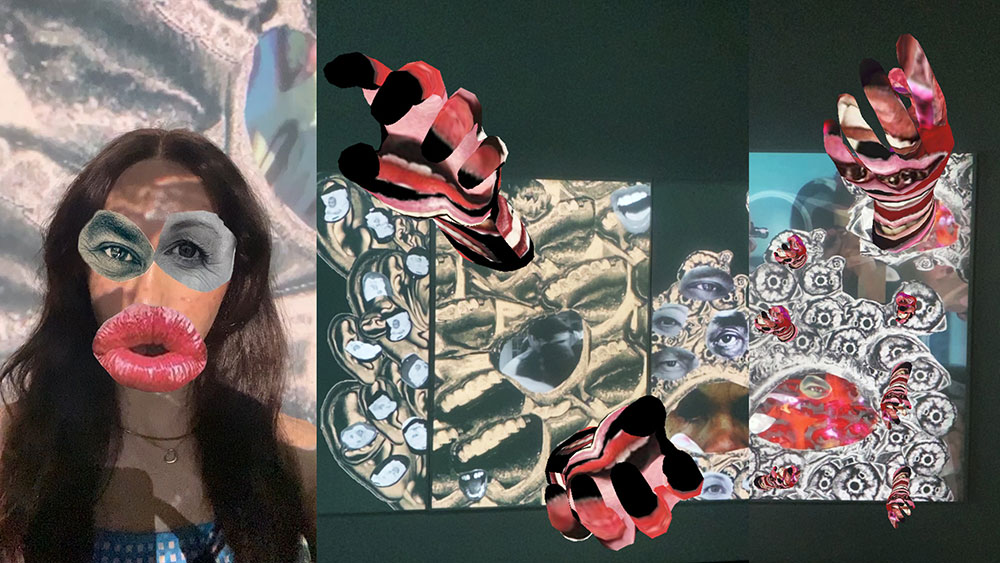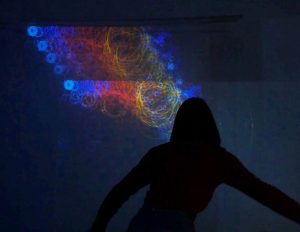
AR filters and video art installation from ‘Distant Distraction, Foul Breach, Separate Sensation’ by Lark Spartin. Images CC BY-SA 2022
Lark Spartin, a recent graduate from UBC Okanagan, presented her first academic publication on Digital Relationality at EVA London this July. EVA London is one of the international Electronic Visualization & the Arts conferences. Through her Bachelor of Media Studies degree, Spartin explored various ways to blend art and technology, and developed a strong technical skillset across a variety of digital media. In John Desnoyers-Stewart’s Media Studies Seminar Series (MDST 490), she began to uncover the under-utilized relational potential that these tools have to connect individuals and inspire creative expression among a wider demographic. John saw the potential value of Lark’s ideas to the larger digital art community and encouraged her to publish, which led them to co-author the EVA London article on Digital Relationality.
“Digital Relationality: Relational Aesthetics in Contemporary Interactive Art” by Lark Spartin and John Desnoyers-Stewart proposes ways in which Nicholas Bourriaud’s Relational Aesthetics can be integrated with contemporary interactive art. Through their publication, presented at the Electronic Visualisation and the Arts (EVA) London conference in July 2022, they analyse their own artworks as examples of how merging relational aesthetics with interactive digital art can benefit both realms. Applying relational aesthetics to digital media reveals the antagonism within the structures imposed by technology that is ordinarily taken for granted. Drawing attention to these structures, and subverting the typical uses of these platforms, allows for reflection and discourse. This can lead both artist and viewer to imagine alternative ways of living beyond the constraints we ordinarily operate within, becoming active participants in constructing a digitally relational future. When relationality is infused into technology by inverting its typical use, artists can encourage those who participate to become creators and performers. Digital relationality provides a way to bring awareness to the role we all have in reshaping the technology we use daily and reflect on the technology that shapes us.
Lark Spartin’s relational artwork, including Gestures and Distant Distraction, Foul Breach, Separate Sensation, has been exhibited at the UBC Okanagan FINA Gallery. Her artwork, mostly focused within digital art, interactive installation, and augmented reality, aims to invert the typical use of digital media to confront entrenched norms of social separation and disembodiment within the use of these tools. As such, she exhibits through online platforms that can reach a broad audience including Instagram filters and websites such as larkbutonline.com. By exploiting and subverting technology that is used to quite literally filter how we relate to our world, ourselves and one another, her work emphasizes the creative and relational potential of the tools that are so ingrained in our everyday communication and creation practices. She aims to continue her research and art practice to create relational artwork that encourages connection and expression from its viewers, changing the landscape of how individuals interact with technology, social media, and each other daily.
John Desnoyers-Stewart is a PhD Candidate at Simon Fraser University’s School of Interactive Arts and Technology. His practice-based research centres around pushing the boundaries of virtual reality, encouraging new perspectives on its capacity to facilitate social connection and encourage self-expression. His interactive VR artworks including Transcending Perception and Body-RemiXer reframe how immersants see each other, encouraging them to dance, play, and connect with one another. His recent telepresent social experience Star-Stuff transforms immersants into constellations and galaxies and is available on AppLab, and will be exhibited at SIGGRAPH 2022 and the H.R. MacMillan Space Centre this fall. He is also collaborating with an international team on a cutting-edge VR performance, Eve 3.0, that transforms audience members into performers through touch and movement. He teaches online courses at UBC Okanagan including MDST 490 Seminar Series and IGS 501 Creative Research Methods.
View Lark’s projects below.
